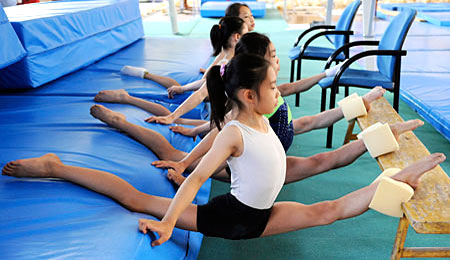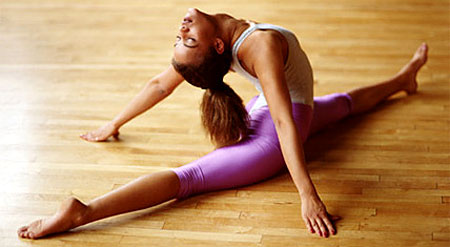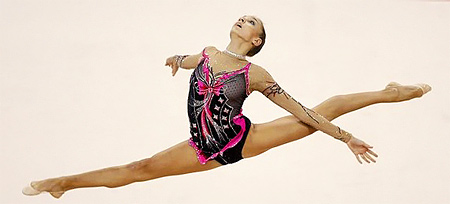 |
Science of fasting |
 |
Periodic fasting and CR prevent aging and rejuvenate the body |
 |
High-protein diet in middle age poses serious health risk |
 |
Treatment of Obesity through fasting |
 |
Management of Diabetes Through Intermittent Fasting |
 |
Longevity Gene: Another scientific step towards longer lives |
 |
Cholesterol Lowering Drug Statin Can Extend Lives of Cancer Patients |
 |
Fasting cycles retard growth of tumors |
 |
Intermittent Fasting for Prevention Obesity and Diabetes by |
 |
New compound in red wine (piceatannol) staves off obesity |
Stretching

Stretching is a form of physical exercise in which a specific skeletal muscle (or muscle group) is deliberately elongated to its fullest length (often by abduction from the torso) in order to improve the muscle's felt elasticity and reaffirm comfortable muscle tone. The result is a feeling of increased muscle control, flexibility and range of motion. Stretching is also used therapeutically to alleviate cramps.
Stretching, in its most basic form, is a natural and instinctive activity; it is performed by many animals including humans. It can be accompanied by yawning. Stretching often occurs instinctively after waking from sleep, after long periods of inactivity, or after exiting confined spaces and areas.
Many athletes stretch deliberately before or after exercise in order to increase performance and reduce injury. Whether it is helpful, has no effect, or even has detrimental effects is in dispute. While common, it may not be beneficial for all athletic activities.
Middle age body flexibility is a measure of arterial flexibility according to a new study published in the American Journal of Physiology.

October 06, 2009, (Sawf News) - Middle age body flexibility is a measure of arterial flexibility according to a new study published in the American Journal of Physiology.
The study found that, among people aged 40 years and older, performance on the sit-and-reach test could be used to assess the flexibility of the arteries.
Because arterial stiffness often precedes cardiovascular disease, the results suggest that this simple test could become a quick measure of an individual's risk for early mortality from heart attack or stroke. "Our findings have potentially important clinical implications because trunk flexibility can be easily evaluated," said one of the study authors, Kenta Yamamoto. "This simple test might help to prevent age-related arterial stiffening."
It is not known why arterial flexibility would be related to the flexibility of the body in middle age and older people. But the authors say that one possibility is that stretching exercises may set into motion physiological reactions that slow down age-related arterial stiffening. Healthy blood vessels are elastic, and elasticity helps to moderate blood pressure. Arterial stiffness increases with age and is a risk factor for cardiovascular disease and death.
Previous studies have established that physical fitness can delay age-related arterial stiffness, although exactly how that happens is not understood. The authors noted that people who keep themselves in shape often have a more flexible body, and they hypothesized that a flexible body could be a quick way to determine arterial flexibility.
The researchers studied 526 healthy, non-smoking adults, 20 to 83 years old, with a body mass index of less than 30. They wanted to see whether flexibility of the trunk, as measured with the sit and reach test, is associated with arterial stiffness. The researchers divided the participants into three age groups: young (20-39 years old), middle aged (40-59 years old) and older (60-83 years old).

The researchers asked participants to perform a sit-and-reach test. The volunteers sat on the floor, back against the wall, legs straight. They slowly reached their arms forward by bending at the waist. Based on how far they could reach, the researchers classified the participants as either poor- or high-flexibility. The researchers also measured blood pressure and the speed of a pulse of blood as it flowed through the body. They measured how long the pulse takes to travel between the arm and the ankle and between the neck and the leg. They also measured aortic pressure in some participants and tested the participants for cardiorespiratory fitness, muscular strength and endurance.
The study found that trunk flexibility was a good predictor of artery stiffness among middle age and older participants, but not among the younger group. In middle age and older participants, they also found that systolic blood pressure (the peak pressure that occurs as the heart contracts) was higher in poor-flexibility than in high-flexibility groups.
What's happening?
Why would the flexibility of the body be a good indicator of arterial stiffness? In the study, the authors speculate on why this would be. One possibility is that there is a cause and effect: the stretching exercises that provide flexibility to the body may also slow the age-related stiffening of the arteries. The study found that arterial stiffness among middle age and older people was associated with trunk flexibility but was independent of muscle strength and cardiorespiratory fitness (as measured by performance on an exercycle). In addition, they cited another recent study that found that middle age and older adults who began a regular stretch exercise program significantly improved the flexibility of their carotids, a major artery found in the neck.
"Together with our results, these findings suggest a possibility that improving flexibility induced by the stretching exercise may be capable of modifying age-related arterial stiffening in middle-aged and older adults," Dr. Yamamoto said.
"We believe that flexibility exercise, such as stretching, yoga and Pilates, should be integrated as a new recommendation into the known cardiovascular benefits of regular exercise."
However, there are other possibilities as to why bodily flexibility should be an indicator of arterial stiffness. One possibility is that it is related to the higher blood pressure that was seen in the poor flexibility group. Another possibility is that the amount of collagen and elastin, which makes the muscles flexible, also makes the arteries flexible. Further research is needed to understand whether there is a cause-effect relationship between flexibility and arterial stiffness, they said.

Possible benefits:
In the literature described by Michael Yessis, there are many beneficial stretches that can improve range of motion (ROM) in athletes, especially runners. In his review, he cites benefits of stretching:
2) reduce risk of injury during activity
3) prevent post-exercise muscle soreness
4) slow delayed-onset muscle soreness (DOMS)
To gain these benefits, Yessis describes different forms of stretching along with their individual benefits. He suggests that one stretching exercise may not be enough to prevent all types of injury. Therefore, multiple stretching exercises should be used to gain the full effects of stretching.
Research by Sharman et al. sought to find what techniques elongate muscles through "proprioceptive neuromuscular facilitation" (PNF) stretching. They used around seventy sources to compile their data. In this review, PNF stretching yielded the greatest change in range of motion (ROM), especially short-term benefits. Ballistic stretching was also beneficial in comparison; however, PNF techniques emphasize active flexibility and therefore get better results. Reasoning behind the biomechanical benefit of PNF stretching points to muscular reflex relaxation found in the musculotendinous unit being stretched. More common findings in literature suggest that PNF benefits are due to influence on the joint where the stretch is felt.

Research and controversy
It has been suggested in some studies that overstretching or stretching to a point where pain is felt is inappropriate and detrimental. Effects on performance, both short and long-term, may include predisposition to injury and possible nerve damage (Yessis 8-18). Other findings in research conclude that active stretching routines will reduce muscle-tendon viscosity and increase muscle compliancy and elasticity. In sports activities where there are little or no short-stretching cycles, (bicycling, jogging, etc.) stretching routines may be detrimental to athletic performance and have no effect on reducing injuries.
In J. C. Andersen’s compilation of lower extremity stretching research, the effects of stretching before and after exercise were reviewed for evidence of muscle soreness. The seven articles referenced in his research came from sources such as MEDLINE and CINAHL. All data used came from studies that used static stretching programs and included average healthy participants between ages eighteen and forty.
The results of Andersen’s research are somewhat limited, due to the nature of the literature he selected; however, his findings suggest that stretching has no beneficial effects on injury reduction. Two to five percent reductions in injury levels lead Anderson to believe stretching routines will not have impact on injury prevention or post-exercise soreness. Also, the concept that stretching decreases risk of injury in active muscles is negated by claims in the literature reviewed. Stretching as observed in the research found increased complaisance in relaxed muscle groups. This idea, in conjunction with stretch tolerance and stretch variability, does not encourage stretching to prevent injuries. The conclusion claims more research is needed to finalize evidence on the benefits of stretching.
A study constructed by Nelson et al. set out to find the correlation between pre-exercise static stretching and its effects on muscle strength endurance. Two experiments were designed to find the initial links between pre-exercise stretching and muscle endurance.
Results of the study found both stretching experiments to reduce effectiveness of muscle strength endurance by up to thirty percent. They suggest that pre-exercise stretching induces a fatigue-like state in muscles which would clearly inhibit performance if the muscle is not at full potential.
Smaller amounts of research included state that stretching may cause ischemia in muscles, which reduces oxygen levels and the ability to remove metabolic waste. Higher levels of metabolic waste create a catalyst that contracts muscles. This may cause muscle injury in individual performance. Other theories included claim active static stretching increases inflow of Ca2+ from extra cellular spaces into the muscles being stretched. The increase of Ca2+ reduced the muscle twitch tension by up to sixty percent. Reasoning behind this claims that increased levels of Ca2+ in resting muscles predisposes individuals to fatigue quicker than individuals who did not stretch.














